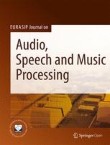Drum Sound Detection in Polyphonic Music with Hidden Markov Models
This paper proposes a method for transcribing drums from polyphonic music using a network of connected hidden Markov models (HMMs). The task is to detect the temporal locations of unpitched percussive sounds (...
